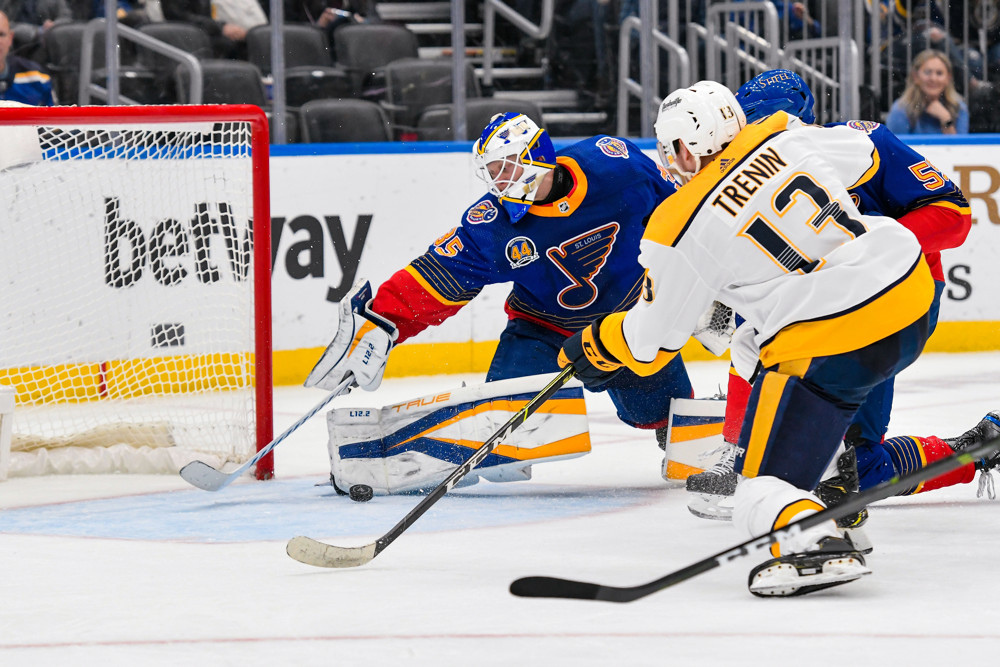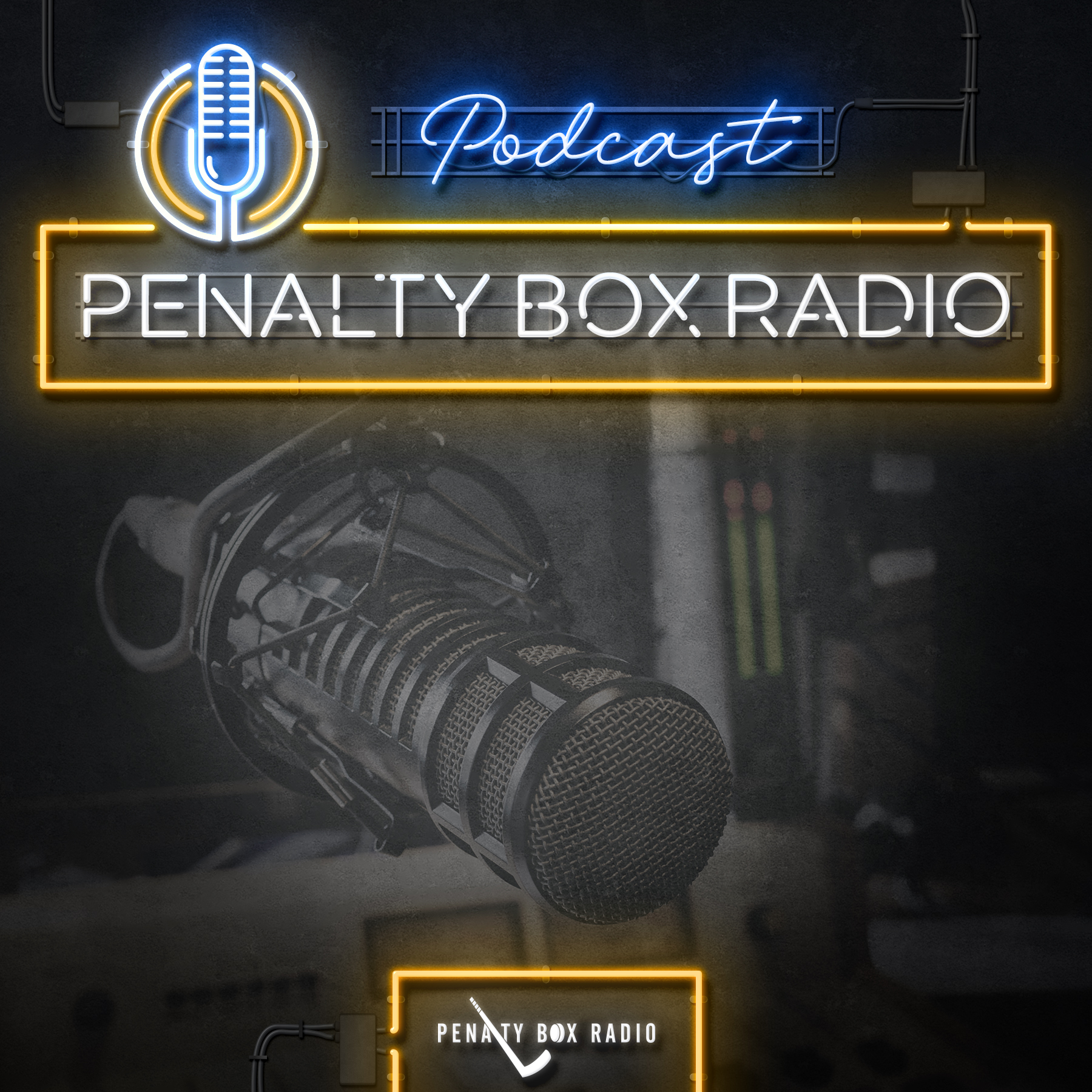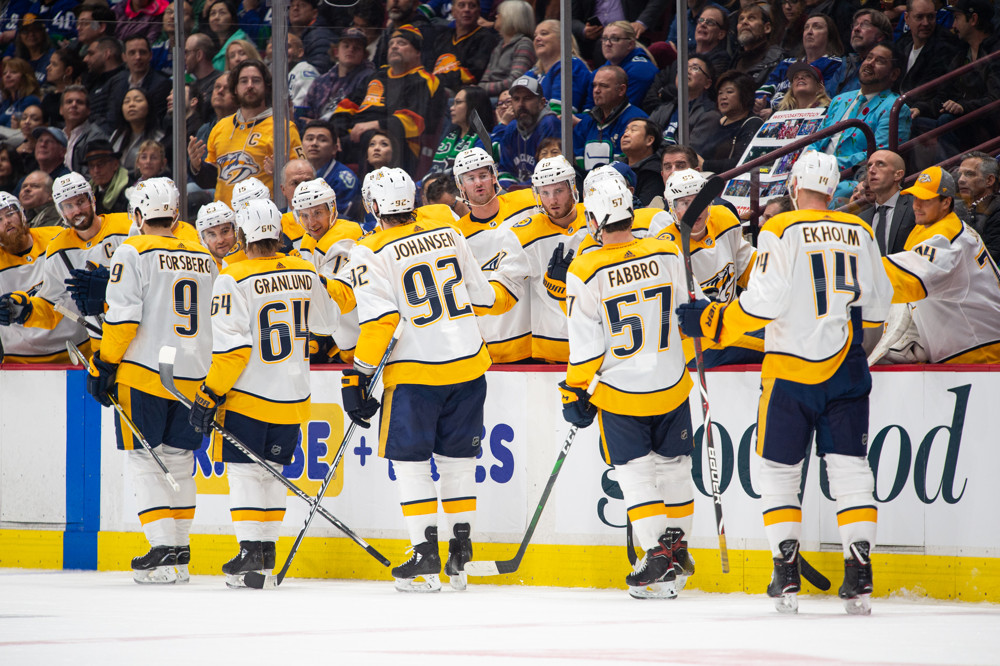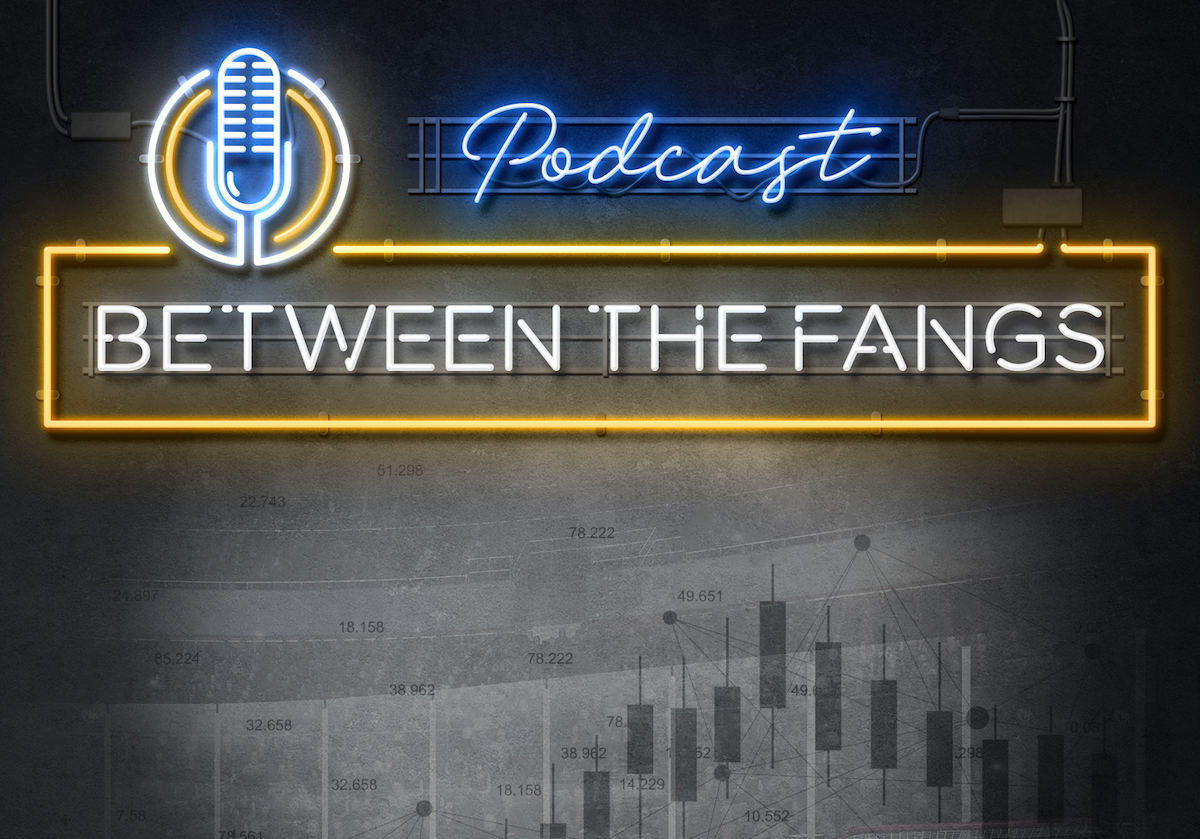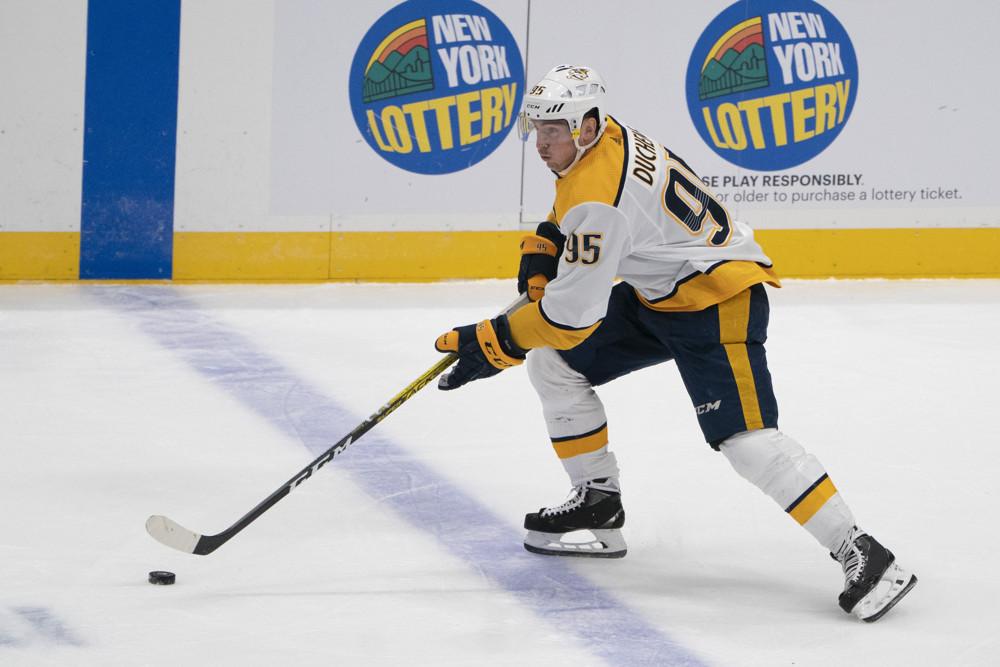 (Editor’s note: These report cards are only for the game being discussed and are an assessment of the analytics for each player/line in the game)
(Editor’s note: These report cards are only for the game being discussed and are an assessment of the analytics for each player/line in the game)
If you disregard the “hockey” element, games between the Anaheim Ducks and Nashville Predators are usually exciting. The penalty box tends to become a bit of a revolving door, as post-whistle scrums continuously erupt and sizzle out. Last night was certainly no exception, as sixteen penalties were awarded over the three period contest.
 There were small helpings of decent hockey, if you paid close attention. Nashville’s power play looked (dare I say) quite good at times. The home team also enjoyed some nice performances from depth forwards. Let’s dive a little deeper and take a look at last night’s report cards.
There were small helpings of decent hockey, if you paid close attention. Nashville’s power play looked (dare I say) quite good at times. The home team also enjoyed some nice performances from depth forwards. Let’s dive a little deeper and take a look at last night’s report cards.
Forwards
The composition of the top line varied somewhat throughout the game, but primarily involved Filip Forsberg, Ryan Johansen, and Austin Watson. Interestingly, Forsberg and Johansen were not on the ice for any of Watson’s three goals, and Watson had been briefly replaced by Miikka Salomaki when Anaheim managed their only five-on-five tally.
 I want to emphasize that “C+” is my grade for this line as a whole at five-on-five. I am aware that Watson scored a hat trick, but Johansen and Forsberg were off the ice during his only five-on-five goal. In terms of puck possession, it was a rare mediocre night from the Predators’ top line. They produced very few shot attempts, and failed to produce a single high-danger scoring chance at five-on-five. The individuals did play well during their many power play opportunities, but including data from power plays is rarely valuable.
I want to emphasize that “C+” is my grade for this line as a whole at five-on-five. I am aware that Watson scored a hat trick, but Johansen and Forsberg were off the ice during his only five-on-five goal. In terms of puck possession, it was a rare mediocre night from the Predators’ top line. They produced very few shot attempts, and failed to produce a single high-danger scoring chance at five-on-five. The individuals did play well during their many power play opportunities, but including data from power plays is rarely valuable.
The Predators placed Kyle Turris on injured reserve prior to this game, resulting in a shaken up second line as well. Fortunately, Nashville has a serviceable second line center in Calle Jarnkrok. He was joined last night by Kevin Fiala and Craig Smith.
 Unfortunately, it was not a good performance from these three. They faced Anaheim’s second defensive pairing and avoided taking a single defensive-zone faceoff at five-on-five, but were still outplayed. They allowed a Ducks advantage in shot attempts and failed to produce a single high-danger scoring chance (though they didn’t allow one either). This line has huge upside, but Fiala continues to be snakebitten and Jarnkrok might have to focus less on his two-way ability and play more offensively for the time being.
Unfortunately, it was not a good performance from these three. They faced Anaheim’s second defensive pairing and avoided taking a single defensive-zone faceoff at five-on-five, but were still outplayed. They allowed a Ducks advantage in shot attempts and failed to produce a single high-danger scoring chance (though they didn’t allow one either). This line has huge upside, but Fiala continues to be snakebitten and Jarnkrok might have to focus less on his two-way ability and play more offensively for the time being.
I continue to be lost on the subject of Ryan Hartman. If I were Laviolette, I’d have him as a member of the top six every night until Arvidsson returns. At many points each game, it seems he’s playing on every line at once. At least to start, he joined Nick Bonino and Colton Sissons on the Predators’ third line last night.

 Overall, I was impressed by these three. In general, the group took advantage of a nice zone deployment and relatively weak opposition, producing a solid +3 in shot attempts. Additionally, Bonino placed a lovely (if uncharacteristic) snipe in the second period to give Nashville the lead. I can’t give an “A” with the high-danger chance value, but this was the Predators’ best line at five-on-five.
Overall, I was impressed by these three. In general, the group took advantage of a nice zone deployment and relatively weak opposition, producing a solid +3 in shot attempts. Additionally, Bonino placed a lovely (if uncharacteristic) snipe in the second period to give Nashville the lead. I can’t give an “A” with the high-danger chance value, but this was the Predators’ best line at five-on-five.
The forward group was rounded out by Frederick Gaudreau, Miikka Salomaki, and Zac Rinaldo. This is one of the few lines that has remained unaffected by injury, but they continue to be a true liability on the ice.
 I can’t, in good faith, give them a straight “F,” since their grade should really be “NA.” With so many penalties and so little five-on-five hockey, this line played even less than usual. With their four faceoffs, none of which were in the defensive zone, they produced one shot attempt and zero high-danger scoring chances. This line’s role in the lineup is clear: give the other nine forwards a breather.
I can’t, in good faith, give them a straight “F,” since their grade should really be “NA.” With so many penalties and so little five-on-five hockey, this line played even less than usual. With their four faceoffs, none of which were in the defensive zone, they produced one shot attempt and zero high-danger scoring chances. This line’s role in the lineup is clear: give the other nine forwards a breather.
Defense
Roman Josi is on pace for an excellent season, and Ryan Ellis has continued to be a great partner for him. While Ellis did attack the crowd with the puck on three separate occasions, the pair’s performance last night was admirable again.
 This grade requires some explanation, as it seems a bit higher than perhaps it should be. While this pair allowed 14 shot attempts against, five of them were blocked before reaching the net. This suggests that, though the Ducks were able to maintain possession and hammer away at the puck, they weren’t finding shooting lanes or good angles. This, paired with the matchup against Getzlaf & Co., is good enough for a “B” average where I’m from.
This grade requires some explanation, as it seems a bit higher than perhaps it should be. While this pair allowed 14 shot attempts against, five of them were blocked before reaching the net. This suggests that, though the Ducks were able to maintain possession and hammer away at the puck, they weren’t finding shooting lanes or good angles. This, paired with the matchup against Getzlaf & Co., is good enough for a “B” average where I’m from.
P.K. Subban remains sidelined with a mysterious injury, but it sounds like he’s been able to get back on the ice recently. For the time being, Dan Hamhuis has enjoyed a placement alongside Mattias Ekholm. I was unsure about Hamhuis earlier in the season, but it seems that he’s a decent defenseman when he’s away from Yannick Weber.
“Getzlaf line” is not a typo here. Apparently, Ryan Getzlaf never leaves the ice (he played over 21 minutes at all strengths last night). As you can probably tell, the major issue here is the difference in high-danger scoring chances. Producing an advantage in shot attempts is beneficial, but not if you allow so many high-quality chances coming the other way. These two may have frequently peppered John Gibson, but they didn’t make Pekka Rinne’s life any easier.
Concluding the skaters are Yannick Weber and Matt Irwin. Normally, I suggest looking away any time you notice that Weber, Irwin, Rinaldo, Gaudreau, and Salomaki are all on the ice together. However, against the injury-decimated Anaheim Ducks bottom six, a positive performance is more or less required.
You’d be forgiven if you said “who on Earth is Kalle Kossila?” He has played a total of 19 career NHL games, and been relatively poor in each one. His linemates, Ben Street and Pontus Aberg, have each made quite a few more NHL appearances, but have rarely summited the hill of mediocrity.
Irwin and Weber did manage to avoid allowing any high-danger scoring chances, but, again, that’s more the expectation than the goal. Facts are facts, though, and they earned a “B” grade for that performance.
 Netminders
Netminders
The major Anaheim vs. Nashville discussion points should really be focused on goaltending. For the first few weeks of the season, Rinne and Gibson occupied the top two positions for league-wide save percentage. Gibson has slipped down recently, but that’s expected when you’re facing more shot attempts per game than any other goalie in the league.
While the third period primarily featured the Ducks trying to complete a pass, Rinne was called on at times to keep the home team alive.
Rinne’s high-danger save percentage is usually much higher, but this was still a nice performance. He made every five-on-five save that was expected, and bailed his team out on a high-danger shot as well. When your team is scoring goals, a 0.933 will typically get the job done. For now, Pekka Rinne is continuing his season-long surge in performance quality.










